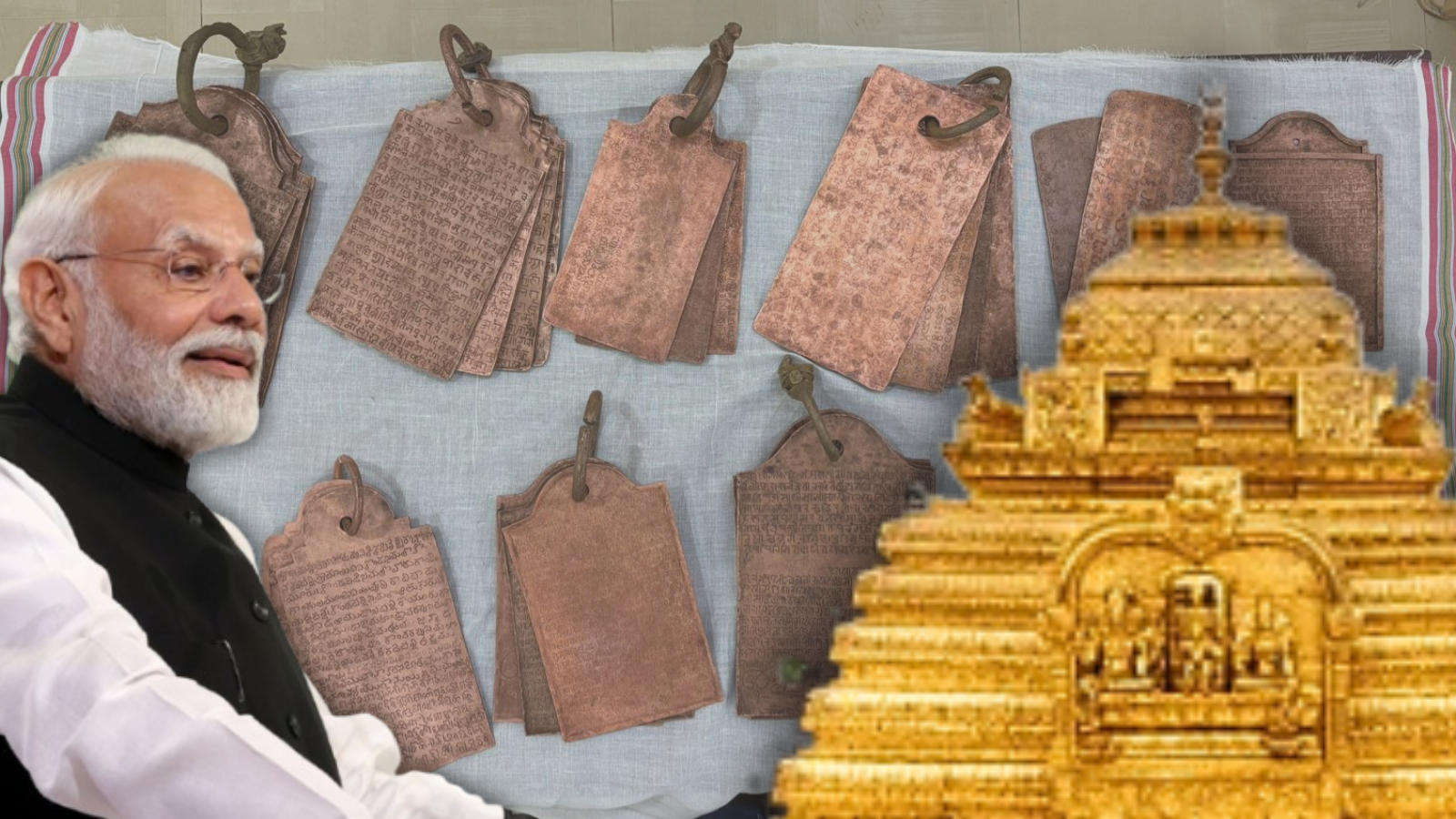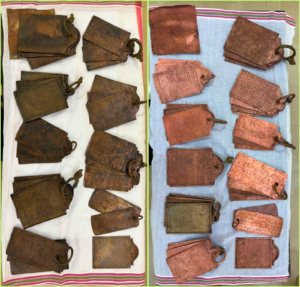The ASI is set to display 21 copper plates revealing the history of Srisailam — the nitty-gritty of daily operations, battles for self-determination and a tryst with the world beyond.
Published Oct 16, 2025 | 9:28 AM ⚊ Updated Oct 16, 2025 | 9:28 AM

Srisailam Copper Plates to be on display during Prime Minister Narendra Modi's visit on 16 October
Synopsis: Prime Minister Narendra Modi is visiting the temple town of Srisailam. Until 2021, centuries of the town’s history were hidden in undiscovered copper plates. These plates contained stories and records from a time long forgotten — a time unknown.
Prime Minister Narendra Modi’s visit to Srisailam on Thursday, 16 October, has got the quiet temple town in Andhra Pradesh buzzing with festive fervour. Amid all the decorations and the preparation for the day to come, one display is intent on looking back at the town’s legacy.
The Archaeological Survey of India (ASI) is set to display 21 copper plates revealing the history of Srisailam — the nitty-gritty of daily operations, battles for self-determination and a tryst with the world beyond.
This display will unravel centuries of history which was lost until 2021. The copper plates, about as big as a modern-day iPad, might not seem impressive at first. However, hammered into it are stories and records of a time forgotten, of a time unknown.
The location of the copper plates was unique in and of itself. “In 2021, the temple staff undertook the routine cleaning of the five Matams, which make up Srisailam.
Nestled within the stone walls of the Gantha Matam, they struck gold, or rather, copper,” Dr K Munirathnam Reddy, the Director of Epigraphy at ASI, recalled.
The Gantha Matam is one of the five constituent Matams of Srisailam, along with the Bheema Sanakara, Vibhooti, Rudraksha, and Sarangadhara Matams. However, even among the group, it stands out as the most ancient site.
A group of eight temples, the Matam, is said to have served as a scholarly institution in the days of yore. As such, there is no shortage of surprises at the temple in 2020, gold and silver coins and rings were discovered at the temple, but a treasure befitting its scholarly legacy came about in 2021 with copper plates.
“The temple staff sent me a photo immediately, prompting me to arrive in Srisailam and inspect the inscriptions closely. I further had it copied and cleaned to understand the period further. In fact, deputed the chemical restoration team from our Hyderabad branch to stay in Srisailam and complete the treatment,” Munirathnam, himself based out of Mysore, reported, highlighting the collaborative effort that went into unearthing a piece of lost history.
In fact, this set of copper plates proved significant not only in understanding the history of Srisailam. Dr Munirathnam claims that it marks two firsts: the first coinage of an irreplaceable term in Indian history and among the first ever records of a cosmological phenomenon in the world.
“The copper plates themselves are not from the same period. They stretch across multiple dynasties that were around the region of Srisailam. You have plates from the Recharlas, the Gajapatis, the Chengalvas, the Reddys, and other dynasties across states. In fact, some of the plates also reflect this, the cross-regional diversity with text in both Telugu and Odiya. The copper plates come from multiple states, including Karnataka, Odisha, and present-day Andhra Pradesh and Telangana,” Reddy detailed, shedding light on the origin of the plates.
“All these plates contribute to the history of Srisailam. Cumulatively, the copper plates detail the bestowment of 75 villages in the region to the temple’s authorities. This is from the various dynasties in various time periods. While some plates detail the bequeathment, others record the construction of various tanks and water projects to serve the region,” he continued.

Copper plates before an after chemical treatment
The 75 villages given to Srisailam reportedly became the means of operating the Saivite pilgrimage site.
“The temple authorities could utilise the revenue from the 75 villages for their rituals. However, it was not just limited to the rituals and the ceremonies. The temple also used the funds to feed pilgrims, visitors, and workers every day. On top of food, the same funds also ensure that the pilgrims have a place to stay as per the inscriptions.” Reddy added.
However, to him, one plate stands out the most. A plate which he claims rewrites the origin of one of India’s most iconic terms, “Swarajya”.
Reddy claimed this term of ‘self-rule’ came from the region of Srisailam, predating the common notion that it came from the Maratha ruler Shivaji. Supporting his claim is a story etched in copper, forgotten in the cracks of the Gantha Matam.
“In 1421, there is a record of a great struggle in the region. When the Turks took over the local Agrahara, Brahmin communities, and ceased the rituals at Srisailam, there was a unique revolt. A local Recharla chieftain, Lingama Nayaka, gave the call for overthrowing the Turks. In his recorded epic, which we unearthed, we found the call he gave ‘Swarajya Punaraddharanam.’” Reddy narrated.
“This,” he said, “marked the earliest use of the term Swarajya in the context of independence, predating even that of Shivaji.”
The term which propelled to the forefront of the Indian Freedom Struggle aside, the copper plates also recorded an event 6,58,22,169.6 kilometres away from Earth. A remarkable 15th-century copper plate inscription from Srisailam opened a new window into India’s celestial past.
Etched in Sanskrit and Nāgari script, the plate, dated to 1456 CE during the reign of Vijayanagara king Mallikārjuna, records a royal grant made to a Vedic scholar, Liṅgaṇārya of Kadapa district.
The grant was made in response to the ominous appearance of a comet and a meteor shower, events believed to bring calamity. The phenomenon is Halley’s Comet, and the copper plate? The first known Indian epigraphical reference to it.
The inscription vividly mentions a “Dhūmakētu mahōtpāta,” or “great calamity caused by a comet,” and “Prakāśāyāya mahōtpāta śāntyartham,” meaning “to pacify the calamities from the blazing comet.”
The king’s response was steeped in ritual: He donated the village of Siṁgāpura as an Agrahara in hopes of warding off its ill effects.
“The Copper inscription reveals the kind of furore the Comet’s sighting caused in India. The kings and scholars were panicked, viewing it as an ill omen.”
As with Mallikārjuna, rulers often ordered elaborate rites and homas to safeguard their kingdoms from cosmic wrath. Munirathnam described the copper plate as “a bombshell of a discovery,” noting its significance “not just for its astronomical value but also for its rare cultural insight.”
The find mirrors global sentiments of 1456, when Halley’s Comet was seen as a harbinger of doom across Europe and Asia. Beyond its celestial note, the plate underscores how deeply ancient India wove astronomy, faith, and governance into one cosmic fabric—where the sky’s fires could sway the fate of kings.
The copper plate display won’t be the only record of history that will mark Prime Minister Modi’s visit to Srisailam on Thursday.
Alongside the display, the ASI is also looking to launch a book detailing its findings, titled Nūtana Tāmra Śāsanālu (New Copper Plate Inscriptions of Srisailam).
Expected to be launched by the prime minister himself, the book and the copper plates will both find their places in the regional history of Srisailam. These copper plates might not be as bright and eye-catching as they once were.
They might not be large enough to inspire awe. They might weigh just as much as a steel plate in your house.
Yet, the earthy, mundane, and rustic plates carry the weight of history, from a people’s devotion, an early fight for “Swarajya,” and a fascination with our place among the stars.
(Edited by Muhammed Fazil.)
